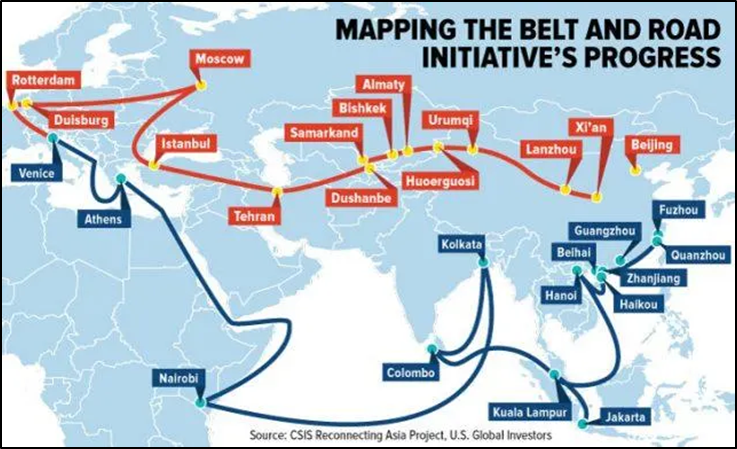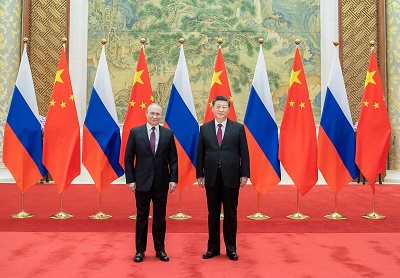Context-
With over 40 meetings in the past 11 years, Russian President Vladimir Putin and Chinese President Xi Jinping share a deep connection. Their recent summit in Beijing on May 16-17, 2024, commemorating the 75th anniversary of diplomatic relations, stands out as one of their most consequential encounters. Given their substantial geostrategic and geoeconomic influence, their "no-limit" bromance has global implications, particularly for India, which maintains complex relationships with both nations.
Historical Phases of Russia-China Ties
- 19th Century: During the 19th century, Czarist Russia exploited a weakened China to expand its territory to the Pacific, an area that the Soviet Union continued to control. This period marked the beginning of a complex and often contentious relationship between the two nations.
- Early Communist Era: Following the establishment of the People’s Republic of China (PRC) in 1949, a decade of "Comintern brotherhood" ensued. However, this camaraderie was disrupted by ideological and geopolitical differences, notably following China's attack on India in 1962. The tensions escalated into armed clashes in 1969 over the Ussuri River border dispute.
- 1972: Shift Towards the West: The fourth phase began with U.S. President Richard Nixon's dramatic visit to Beijing in 1972, aiming to pivot China away from the Soviet-led Eastern Bloc. China tilted towards the West, which supported Deng Xiaoping’s "four modernizations" under the belief that prosperity would liberalize Chinese society. Despite the Tiananmen Square crackdown in 1989, the West continued its engagement with China, providing investments, technology transfers, market access, and diplomatic support, transforming China into the "World’s Factory."
- Post-Soviet Era: After the Soviet Union's collapse, Russia-China ties weakened as the Russian Federation, the Soviet successor, lost much of its influence in Central Asia, which became a new arena for geopolitical competition with China.
- Current Phase: Strategic Convergence Against the West: The current phase began in 2012 when China's growing assertiveness alarmed the U.S., prompting a strategic "pivot to Asia" and policies aimed at stemming China's rise. Increasing friction with the West led China to seek a closer alliance with Russia. Following their 2022 Beijing Summit, they declared their ties had "No Limits." The subsequent Russian invasion of Ukraine and the West's severe sanctions on Moscow pushed Russia further into China's embrace. Their mutual adversarial stance towards the West has driven a significant surge in bilateral relations, with trade reaching $240 billion in 2023, a 26% increase from the previous year.
The Beijing Summit: Key Outcomes
- Economic and Military Cooperation: Despite the impressive trade figures, the 7,000-word Joint Statement issued post-summit was notably silent on specific economic, financial, and military ties. This silence could stem from a desire to avoid provoking Western sanctions or to mask underlying disagreements between Russia and China.
- Strategic Focus on the U.S.: The joint statement harshly criticized the U.S., accusing it of pursuing "dual containment" against both Russia and China and condemning its "Indo-Pacific Strategy" as destabilizing. This indicates a clear strategic alignment between Moscow and Beijing against perceived U.S. hegemony.
Short-Term Impacts
- Intensified Bilateral Cooperation: In the short term, the summit is likely to lead to increased, though discreet, cooperation between Russia and China. This includes the supply of dual-use materials essential for Russia's military operations in Ukraine. In return, China may seek better terms for Russian raw materials, mining rights in Siberia, and access to critical Russian technologies, including avionics, nuclear power, and space.
- China’s Strategic Gains: China might also leverage Russia's dependence to strengthen its influence over Central Asia and secure favorable agreements. The continuation of the Ukraine conflict keeps Russia reliant on China and preoccupies the U.S., allowing China more freedom to assert its dominance in Asia.
Long-Term Implications
- Economic and Geopolitical Contradictions: In the long run, China's dual engagement with Russia and the West presents inherent contradictions that may become untenable. While China benefits from its economic ties with the West, continued Western pressure might force it to more decisively support Russia, potentially leading to a new Cold War.
- Emerging Global Polarization: The summit could herald a new era of global polarization, with China leading an alternative global construct to the U.S.-dominated post-World War II order. Early signs include the expansion of BRICS, the Shanghai Cooperation Organisation, the Asian Infrastructure Investment Bank, and the Belt and Road Initiative. These institutions, with significant Chinese influence, aim to create a credible alternative to Western dominance.

Impact on India
● Strategic Challenges and Opportunities: India faces both challenges and opportunities from the evolving Russia-China relationship. India must carefully assess the depth and durability of this phase, considering the historical volatility of Russia-China ties. Russia’s current economic and military dependence on China, exacerbated by the Ukraine war and sanctions, makes Moscow a less equal partner, raising concerns about China's potential hegemony over Russia.
● Defense Dependencies and Strategic Autonomy: India, heavily reliant on Russia for defense supplies amid ongoing border tensions with China, must consider the implications of Russian vulnerability to Chinese pressure. Although India is Russia's largest defense market, the reliability of these supplies could be compromised.
● Navigating Global Architectures: India, with reservations about the existing global order, must evaluate whether China’s proposed alternatives align with its interests. India’s strategic autonomy, hard-earned over recent decades, provides it with options that require a nuanced and pragmatic approach to leverage its strengths.
Conclusion
Reflecting on the last Cold War, India often prioritized high moral ground over core national interests, which hindered its socio-economic development. In the impending global polarization, India must adopt a clear-eyed strategy, focusing on its long-term national goals and leveraging its strategic autonomy.
India should adopt a sharper and more agile approach, using its significant global influence to navigate the evolving geopolitical landscape. As new opportunities arise, India must remain focused on its core objectives, ensuring it plays a pivotal role in shaping the future global order.
|
Probable Questions for UPSC Mains Exam-
|
Source- The Hindu







